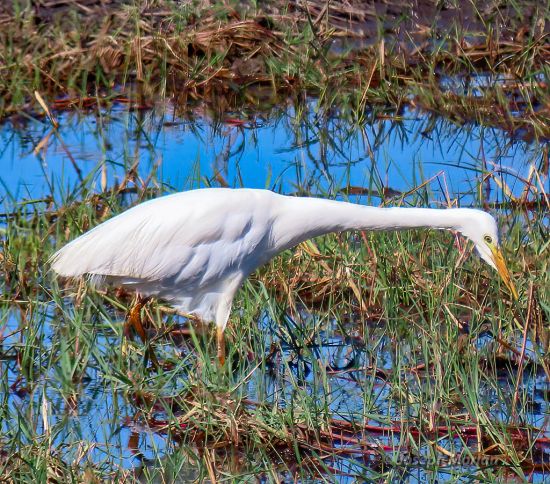Alternative Name(s): Median Egret
- Ardea brachyrhyncha
Mesophoyx brachyrhyncha
Egretta brachyrhyncha
Identification
56–72 cm (22-28 in). Medium-sized white egret.
- all white
- bill relatively short (medium), robust
- gape does not extend beyond eye
- neck generally without pronounced kink (or reduced compared with Great Egret)
- head rounded
Nonbreeding:
- bill yellow (sometimes reddish)
- legs black below 'knee': yellow, grey or reddish above
- Possibly wisps of fine breast plumes
Breeding
- Long filmy, erectile plumes on back and breast
- Red-orange bill
- Lime-green facial skin
- Tibia reddish
- Tarsi black
Similar Species
Most similar to Great Egret, Yellow-billed Egret differs as follows:
- smaller, daintier, more graceful with extended head and neck about equal to body length
- line of gape extends to just below eye (Great Egret's extends well past it)
- head is rounder
- bill shorter and deeper (around 1-1.5x head length cf 2x for Great). The shorter bill also gives Intermediate's head a more triangular look than the attenuated snake-like head of Great Egret
- feathered chin of Yellow-billed extends farther forward along the lower mandible
- adult Yellow-billed usually has longer plumes on the breast
- Yellow-billed tends to be in more vegetated, marshy sites
- (Yellow-billed frequently has a less pronounced neck kink than Great. However, this character is not failsafe: an egret without a link is likely Yellow-billed but one with one may not be Great)
You can confuse Yellow-billed non-breeding with non-breeding Western Cattle Egret. The latter:
- is significantly smaller (where this is possible to judge). The largest Cattle Egrets are around 85% of the smallest Yellow-billed
- is more squat with a proportionately shorter neck
- has facial skin the same colour as its bill (usually a different, paler yellow in Yellow-billed)
- has throat and chin feathering which extends further along the lower mandible than in Yellow-billed
- is more round-headed in appearance with a "deeper" head
- shows less tibia above the "knee" than Yellow-billed
- lacks the more extensive diaphanous plumes hanging from Yellow-billed's scapulars and breast (may be difficult to see)
Distribution
Found throughout much of sub-Saharan Africa from Senegal to Sudan and south to South Africa but absent from the most arid and densely forested areas. Non-migratory but dispersive.
Recorded as a scarce spring and summer visitor to the Banc D'Arguin in Mauritania, and a vagrant to the Cape Verde Islands, Egypt and at the Dead Sea in Jordan.
In May 2001 the first Yellow-billed Egret for Europe was recorded in a small wetland close to Rome, Italy, and remained there until August. In Asia vagrants have been recorded north to Sakhalin.
Taxonomy
Formerly considered a race of Intermediate Egret A. intermedia but now recognized as a full species. Formerly placed in Egretta or in Mesophoyx, however, most authorities now agree on Ardea.
Subspecies
This is a monotypic species. [1]
Habitat
Freshwaters, including slow-flowing rivers, lakes and swamps, also coastal mudflats and mangroves, sometimes grassland.
Behaviour
Breeding
Breeds in colonies, often with other species of herons/egrets.
Diet
Their diet consists of smaller fish, eels, frogs, snakes and insects.
References
- Clements, J. F., P. C. Rasmussen, T. S. Schulenberg, M. J. Iliff, T. A. Fredericks, J. A. Gerbracht, D. Lepage, A. Spencer, S. M. Billerman, B. L. Sullivan, and C. L. Wood. 2023. The eBird/Clements checklist of Birds of the World: v2023. Downloaded from https://www.birds.cornell.edu/clementschecklist/download/
}#Handbook of the Birds of the World Alive (retrieved July 2015)
- BF Member observations
Recommended Citation
- BirdForum Opus contributors. (2025) Yellow-billed Egret. In: BirdForum, the forum for wild birds and birding. Retrieved 11 May 2025 from https://www.birdforum.net/opus/Yellow-billed_Egret
External Links
GSearch checked for 2020 platform.




